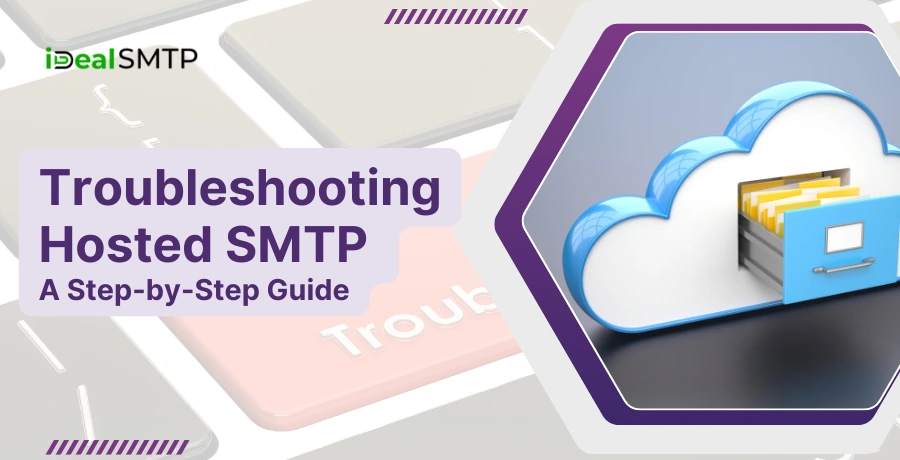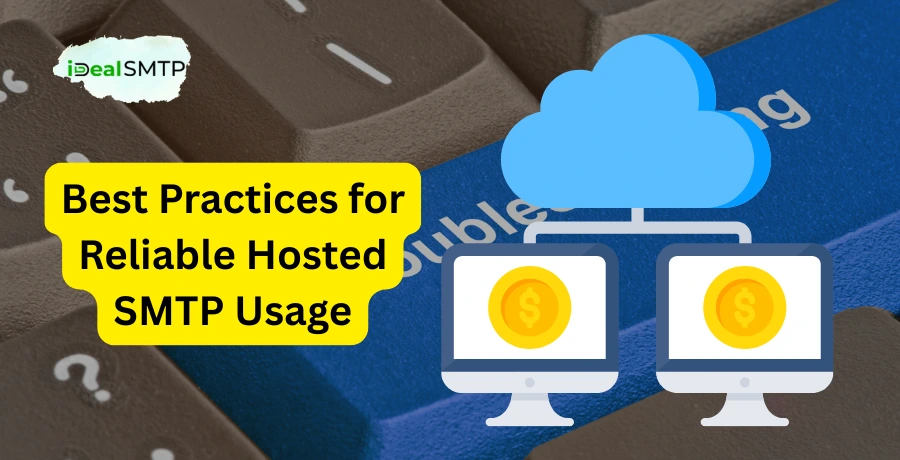Email is an important part of communication for businesses and individuals. It is used daily to send newsletters, order confirmations, or contact form messages. However, sometimes, sending emails through a Hosted SMTP server can fail. When that happens, it’s important to know how to fix it.

This blog will explain how to troubleshoot problems with Hosted SMTP in simple language. We will examine common issues, how to fix them, and how to ensure that your emails are delivered correctly.
We will also discuss terms like hosted SMTP, SMTP server host, Gmail, hosted SMTP server, hosted SMTP relay, hosted SMTP service, and self-hosted SMTP server. If these terms sound confusing now, don’t worry—we’ll make everything easy to understand.
Table of Contents
Pricing
| Trail Plan | Standard Plan | Premium Plan | Professional Plan |
| $50 | $145 | $185 | $225 |
| Sending Limit | Sending Limit | Sending Limit | Sending Limit |
| 1000 Emails/Hour | 1500 Emails/Hour | 3000 Emails/Hour | 5000 Emails/Hour |
What Is Hosted SMTP?
SMTP stands for Simple Mail Transfer Protocol. It is the system that helps send emails from one server to another. When you use a hosted SMTP, it means the SMTP server is provided by a company and hosted on their systems. You don’t need to build or manage the server yourself.
With a hosted SMTP service, you get access to a reliable server that is always online. This helps ensure that your emails are sent quickly and correctly. Hosted SMTP is used by businesses that send a lot of emails, like e-commerce stores, marketing agencies, or customer service platforms.
Hosted SMTP vs Self-Hosted SMTP Server
Let’s understand the difference between a hosted SMTP server and a self-hosted SMTP server.
When you use a self-hosted SMTP server, you are running the email server on your own hardware or hosting account. This gives you full control but also means more responsibility. You must handle security, maintenance, updates, and spam prevention yourself.
With a hosted SMTP service, you pay a company to manage the SMTP server for you. They take care of everything, including speed, uptime, security, and deliverability. Most businesses prefer hosted SMTP to avoid technical challenges.
Why SMTP Email Sending May Fail
Sometimes, even if everything looks right, emails may not get delivered. This is frustrating, especially when you’re using a hosted SMTP relay. Here are some common reasons for email sending issues:
- Wrong login details
- SMTP email server settings are incorrect
- Internet connection problems
- Email blocked due to spam filters
- SMTP Authentication Problems
- DNS records are not set up correctly
- IP address blacklisted, email blacklisted
In the next sections, we will explain how to fix each of these problems step by step.
Step 1: Check Your SMTP Login Details
The first thing to check is your SMTP login details. If your email client or website cannot log in to the SMTP server, the email won’t be sent. This happens often when the username or password is wrong.
Make sure you are using the correct:
- SMTP username (usually your email address)
- SMTP password
- SMTP server host (for Gmail, this is smtp.gmail.com)
- SMTP port (usually 587 or 465)
- Security method (TLS or SSL)
If you are using the SMTP server host Gmail, double-check that your Gmail account has allowed less secure apps or that you are using an app password for added security.
Step 2: Confirm SMTP Server Settings
After checking the login details, confirm that your hosted SMTP server settings are correct.
If you are using a third-party hosted SMTP service, go to their dashboard or documentation and look for the SMTP settings. Usually, they will provide:
- SMTP server address (like smtp.example.com)
- SMTP Port number
- Encryption type (SSL/TLS)
- Authentication method
Use these details in your email application, website plugin, or email automation software.
Step 3: Test SMTP Connection
Before sending real emails, test your connection to the SMTP server. You can use a simple tool like Telnet or a free SMTP testing tool online.
This step helps you know whether your server is reachable. If the test fails, you may have a firewall blocking the port, or the server may be down. In such cases, contact your hosting provider or email service support.
Step 4: Check DNS Records
If you are using a custom domain with your hosted SMTP relay, DNS records must be correct. These include:
- SPF (Sender Policy Framework)
- DKIM (DomainKeys Identified Mail)
- DMARC (Domain-based Message Authentication)
These records tell receiving mail servers that your domain is allowed to send emails. If they are missing or wrong, your email may land in spam or not be delivered at all.
Ask your hosted SMTP provider for the correct DNS values and update them in your domain settings.
Step 5: Check Email Content and Spam Filters
Sometimes, emails are rejected or go to spam because of what they contain. Avoid using spammy words like “free money”, “buy now”, or “urgent offer”. These trigger spam filters.
Also, keep your message clean—avoid large attachments, broken HTML, and too many links.
If you are using a hosted SMTP service, ask if they provide spam testing tools. Many good services can test your email content before sending.
Step 6: Monitor Email Logs
Most hosted SMTP servers offer a way to view email logs. These logs show whether your emails were sent, delayed, or failed. They also show error codes like 550 (mailbox not found) or 421 (server not available).
Reviewing logs helps you understand what went wrong. If needed, you can share these logs with your SMTP support team for faster troubleshooting.
Step 7: Handling SMTP Blacklist Issues
Sometimes your emails may not reach inboxes because the IP address of your SMTP server is blacklisted. A blacklist is a list of servers that are known for sending spam or unwanted emails. If your hosted SMTP server is on such a list, your emails may get blocked.
To check if your server is blacklisted, use tools like MXToolbox or DNSBL. Enter your SMTP server’s IP address and check the results.
If your server is blacklisted, contact your hosted SMTP service provider. They may move you to a different IP or help remove the IP from the blacklist.
If you are using a self-hosted SMTP server, you must take extra steps to secure your server and request delisting from blacklists yourself.
Step 8: Use a Different Port or Encryption
SMTP servers usually support multiple ports. If one port is blocked by your internet provider or hosting company, try another one.
Here are common SMTP ports:
- Port 25 – traditional SMTP (often blocked by ISPs)
- Port 465 – SMTP with SSL encryption
- Port 587 – SMTP with TLS encryption (recommended)
If you are having trouble sending email, switching from Port 25 to Port 587 or 465 can help. Also, check whether you’re using the correct encryption method. Using SSL instead of TLS or vice versa can fix some connection errors.
Your hosted SMTP relay provider can tell you which ports and encryption types they support.
Step 9: Test with a Different Email Address or App
Sometimes, the problem may not be with your hosted SMTP at all. It could be the email address or software you’re using.
To check this, try sending an email using a different email client like Thunderbird, Outlook, or even a basic script using a different email address. You can also use web-based SMTP testing tools.
If emails are sent successfully using another tool or address, then the issue is with your original app or email setup.
This method helps isolate the problem so you can fix it faster.
Step 10: Contact Your SMTP Support Team
If you’ve tried all the steps above and still can’t solve the problem, it’s time to contact your hosted SMTP service support team.
Most SMTP providers offer live chat, email, or ticket-based support. When contacting them, give detailed information such as:
- Your domain name
- SMTP error messages or logs
- What you’ve already tried
Good hosted SMTP companies have skilled support teams who can quickly solve issues. They may also help adjust your account settings to improve deliverability.
Preventing Future SMTP Email Delivery Issues
Now that your email issue is fixed, it’s important to prevent it from happening again. Here’s how you can avoid future SMTP problems:
- Keep your SMTP credentials safe
- Regularly check your DNS settings
- Monitor your sender reputation
- Avoid spammy content in your emails
- Use a professionally hosted SMTP server
- Test your email setup after any changes
If you use a self-hosted SMTP server, make sure to update software, apply security patches, and monitor logs often.
Best Practices for Reliable Hosted SMTP Usage
Using a hosted SMTP relay correctly will help make sure your emails are always delivered on time. Here are some easy-to-follow best practices:

Keep your list clean. Remove invalid email addresses and users who unsubscribe. Sending emails to bad addresses can harm your reputation.
Use double opt-in. This ensures people want your emails and helps avoid spam complaints.
Send emails regularly. Sudden high volumes of email can trigger spam filters. Sending emails steadily helps warm up your sender IP.
Authenticate your domain with SPF, DKIM, and DMARC records. This tells other servers that your emails are trustworthy.
Track your bounce rates and spam complaints. Most hosted SMTP services give dashboards and reports that show your sending stats. Use this data to improve your email campaigns.
When to Use a Hosted SMTP Service
A hosted SMTP service is best for businesses that want reliable email delivery without managing technical stuff. Use a hosted SMTP service if:
- You send newsletters, alerts, or transactional emails
- You want someone else to handle server security
- You need high delivery rates with less effort
- You don’t want to manage a self-hosted SMTP server
Many email marketing tools use hosted SMTP in the background to send your emails. But if you’re building a custom app or website, you might set up the hosted SMTP yourself.
Some popular hosted SMTP providers are SendGrid, Mailgun, SMTP2GO, Amazon SES, and Postmark. Even Gmail offers SMTP server host Gmail settings for sending mail from your domain or app.
When to Consider a Self-Hosted SMTP Server
While most businesses use hosted services, some developers or tech-savvy users prefer a self-hosted SMTP server. This gives you full control over your email system.
You may want to consider a self-hosted SMTP if:
- You want to save on monthly service fees
- You need full customization and server access
- You are sending internal emails within a company
- You are running a private email server for your organization
However, be prepared to deal with security updates, server downtime, and deliverability issues. Setting up and maintaining a self-hosted SMTP server takes time and knowledge.
SMTP Server Host Gmail: A Simple Option for Small Businesses
If you want to send emails from your website or app but don’t need advanced features, you can use the SMTP server host Gmail settings.
Gmail allows you to send up to 500 emails per day from your account. If you have Google Workspace (formerly G Suite), you get even more sending capacity.
Here are the Gmail SMTP settings:
- SMTP server: smtp.gmail.com
- Port: 587 (TLS) or 465 (SSL)
- Requires authentication: Yes
- Username: your full Gmail address
- Password: your Gmail or app-specific password
Make sure to enable “Allow less secure apps” or use 2-Step Verification with an app password.
This option is perfect for small websites, blogs, or solo professionals who need basic email sending.
Hosted SMTP Relay for Better Email Volume and Delivery
As your email needs grow, a hosted SMTP relay becomes necessary. This system lets you send large numbers of emails through a professional server that handles routing, spam protection, and speed.
SMTP relay providers usually offer features like:
- High-volume sending limits
- IP reputation management
- Advanced reporting tools
- API access for developers
- SMTP failover and backup
Using a hosted SMTP relay means your emails are less likely to be marked as spam. You also get better customer support and faster email delivery.
Common Hosted SMTP Errors and Their Fixes
Here are some frequent error messages you might see with hosted SMTP and how to fix them:
“550 – Relay not permitted”
This means the SMTP server won’t send emails for you. Make sure you are logged in and authenticated properly.
“421 – Service not available”
The server may be down or overloaded. Try again later or contact support.
“Authentication failed.”
Your SMTP username or password is incorrect. Double-check your login details.
“Connection timed out.”
Your server cannot reach the SMTP server. Check firewall rules or try another port.
“Email marked as spam”
Improve your email content, check SPF/DKIM/DMARC, and clean your list.
Final Thoughts
Troubleshooting a hosted SMTP setup doesn’t have to be overwhelming. A systematic approach that checks server settings, authentication, DNS records, bounce codes, and sender reputation can resolve most problems quickly.
Whether you’re running marketing campaigns, sending transactional emails, or managing notifications, maintaining a healthy SMTP environment is critical for reliable email delivery. When in doubt, leverage your SMTP provider’s support and analytics to get back on track efficiently.
FAQs
Here are the top FAQs on the hosted SMTP blog:
1. What is Hosted SMTP?
Hosted SMTP is an email service that sends your emails through an external server, managed by a third-party provider.
2. How does Hosted SMTP differ from Self-hosted SMTP?
Hosted SMTP is managed by a service provider, while self-hosted SMTP is maintained by you or your team on your own server.
3. Why is my Hosted SMTP server not working?
Issues can arise from incorrect login details, server settings, network problems, or blacklisting.
4. What are the risks of using a self-hosted SMTP server?
Managing a self-hosted SMTP server requires technical expertise and can expose you to security risks and deliverability issues.
5. How do I contact support for Hosted SMTP issues?
Reach out to your service provider’s support team with error logs and details of your issue for quicker resolution.
6. What is the difference between SMTP and IMAP/POP3?
SMTP is used for sending emails, while IMAP and POP3 are used for receiving emails.







